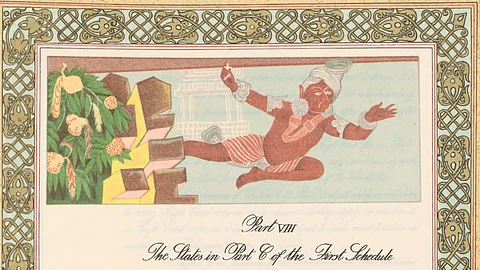
- HOMEGROWN WORLD
- #HGCREATORS
- #HGEXPLORE
- #HGVOICES
- #HGSHOP
- CAREERS
- ABOUT US
- CONTACT US

A constitution is the most sacred document of the land. It’s a bedrock of legal principles guiding governance, democracy, and justice. Yet, India’s Constitution is far more than a legal manuscript. It’s also a piece of visual artwork. Handcrafted with calligraphic precision by Prem Behari Narain Raizada and illustrated with artwork by Nandalal Bose and his students from Shantiniketan, the original manuscript is a confluence of law and art. The Constitution of India weaves together history, mythology, philosophy, and national identity through 22 illustrations that span millennia. These pieces of art, rich in detail and narrative depth, transform the Constitution from a legal charter into a cultural and historical artefact. There is no greater testament to India’s syncretic past and its democratic aspirations.
At its core, the Indian Constitution embodies the will of the people. The manner in which it was originally presented elevates it beyond a mere legal text. From the Ashokan Lion Capital on its opening page — its bold, sculptural form a reminder of India’s enduring sovereignty — to the intricate, fluid strokes of Raizada’s calligraphy, every aspect of its physical form is artistic. But it’s the illustrations — each from a different era in Indian history — that give the Constitution a soul.
These 22 illustrations are not random. They were meticulously chosen to represent the trajectory of Indian civilization. From the seals of the Indus Valley Civilization to the tumult of the independence movement, they embody deliberate and chronological storytelling. Their presence is a reminder that the past is not a relic but an active force shaping the future of the nation.
Each part of the Constitution is introduced with an illustration that grounds it in cultural memory. The artwork covers a wide spectrum of themes — spiritual, political, artistic, and historical — capturing the essence of Indian identity across centuries.
The Constitution begins with a seal from the Indus Valley Civilization, the zebu bull, a symbol of economic prosperity and early urban sophistication. The choice of this image for Part I, which deals with the Union and its territories, reminds us that the Indian subcontinent has been home to organized polity and governance for millennia.
Following this, Part II, which addresses citizenship, is introduced with a scene of a Vedic gurukul, a symbol of India’s deep-rooted tradition of knowledge and wisdom. It points to the fact that education and cultural identity have always been intertwined in the Indian consciousness.
Part III, detailing Fundamental Rights, is adorned with a scene from the Ramayana. Rama, Sita, and Lakshman symbolize the moral duties of rulers and the inherent rights of individuals — dharma triumphing over adharma.
The Bhagavad Gita’s depiction in Part IV, corresponding to the Directive Principles of State Policy, is equally compelling. Krishna’s discourse to Arjuna at Kurukshetra is an allegory for the moral and ethical dilemmas inherent in governance, urging the state to uphold righteousness.
The Constitution does not limit itself to mythological grandeur. It also celebrates historical figures who shaped India’s destiny. Gautama Buddha’s first sermon, symbolizing enlightenment and ethical governance, graces Part V on the Union.
Mahavira’s meditative presence in Part VI reinforces the principle of non-violence, a cornerstone of India’s moral philosophy.
Ashoka, the Mauryan emperor who embraced Buddhism and spread its message across Asia, appears in Part VII. His mission of peace mirrors the Constitution’s aspirations for social harmony.
Meanwhile, the court of King Vikramaditya, known for its patronage of scholars and artists, finds its place in Part IX, dedicated to panchayati raj.
The medieval period is represented with a composition of Mughal Emperor Akbar’s court in Part XIV, a nod to his administrative prowess and syncretic approach to governance.
The illustrations take a turn towards resistance and defiance with the inclusion of Chhatrapati Shivaji Maharaj and Guru Gobind Singh in Part XV, devoted to elections — an assertion that democracy is built on the foundation of courage and self-determination.
As the Constitution moves into its latter sections, the illustrations pay homage to India’s long and arduous fight for independence. Mahatma Gandhi appears in two separate depictions: leading the Dandi March and visiting Noakhali, the former for civil disobedience, the latter alludes to his moral compass.
Netaji Subhas Chandra Bose stands tall in Part XIX, saluting the Azad Hind Fauj, symbolizing the indomitable spirit of resistance.
The Constitution concludes with landscapes — Himalayan peaks in Part XX, rolling desert dunes in Part XXI, and boats sailing across the waters in Part XXII. These depictions are symbolic of India’s diverse terrain and the geographical unity that binds its people together.
Incorporating these illustrations was a profound act of nation-building. These visuals serve as a moral and cultural conscience, urging future generations to remember that democracy is not just about laws and statutes — it's about the people, their stories, their struggles, and their triumphs.
At a time when digital renditions of the Constitution often exclude these, it’s imperative to re-engage with them. Each brushstroke by Nandalal Bose and his team; every carefully chosen motif, is a testament to the grand vision of a nation that sought to define itself. Through its imagery, the Constitution tells a story — one that is as grand, complex, and enduring as India itself.
View the entire Constitution here.
If you enjoyed reading this, here's more from Homegrown:
Nani Palkhivala, The Indian Lawyer Who Redefined The Indian Constitution
This Republic Day, Meet The Calligraphy Artists Behind The Indian Constitution
